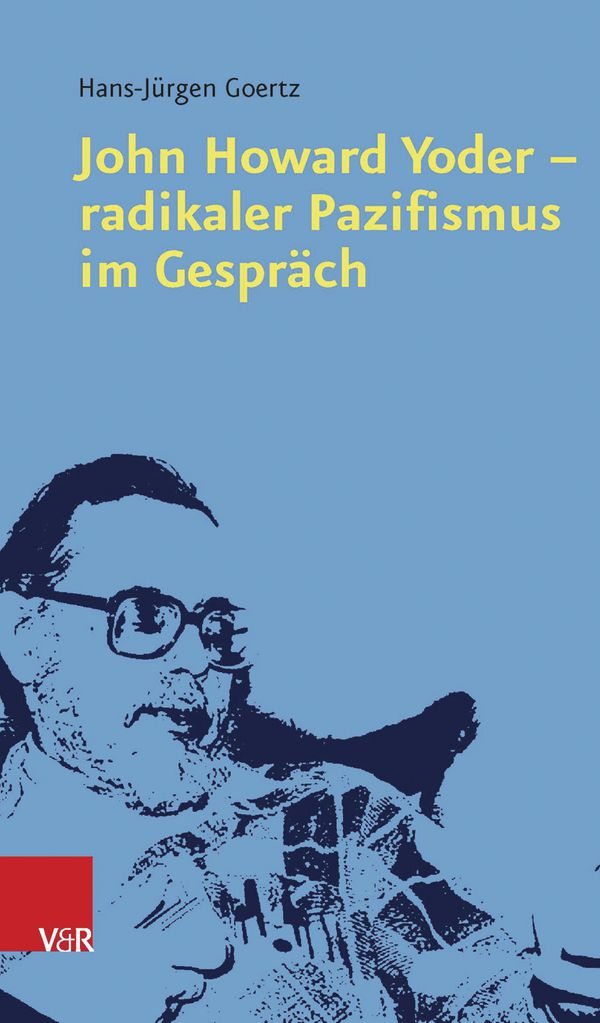 John Howard Yoder — radikaler Pazifismus im Gespraech by Hans-Jürgen Goertz
John Howard Yoder — radikaler Pazifismus im Gespraech by Hans-Jürgen Goertz
Review: Radikaler Pazifismus im Gepsräch
Hans-Jürgen Goertz, Radikaler Pazifismus im Gepsräch. Vandenhoeck & Ruprecht, 2013.
In this volume Hans-Jürgen Goertz, retired professor of social history at the University of Hamburg and leading historian of the Anabaptist movement, offers the first book-length study in German of John Howard Yoder’s theology. [Since the book’s publication, two additional German-language books that engage Yoder’s work have appeared: Marco Hofheinz’s study brining Yoder’s pacifism into conversation with Karl Barth’s christologically-rooted peace ethic and Joel Driedger’s introduction to Yoder’s theology.1] Goertz and Yoder had at times conflicting historical interpretations of sixteenth-century Anabaptism: Goertz’s exposition of Yoder’s theology also reveals their conflicting theological visions.
The title of Goertz’s study promises an examination of Yoder’s radical pacifism in conversation.
This promise is fulfilled in part through Goertz’s exploration of how Yoder’s historical-theological interpretation of the Anabaptist movement and his theological accounts of church unity and the church’s peace witness were developed through conversations with a wide variety of interlocutors. Goertz devotes an initial chapter to Yoder’s formative years in Europe as a student of Karl Barth and Oscar Cullman and as a leader in the Concern Group, a renewal movement of North American Mennonite graduate students and relief workers in post-World War II Europe. Later chapters flesh out how ecumenical conversations about unity and peace decisively shaped Yoder’s theology.
Yet Goertz’s volume is not simply an examination of how Yoder’s theology was shaped through conversations with others. Rather, this book represents Goertz’s extended conversation with Yoder’s writings. Conversation is perhaps too tame a word—disputation may be more appropriate. Goertz follows exposition of Yoder’s positions on different issues with extended critique. In the course of this critique Goertz points to his own constructive theological vision, one shaped by a particular interpretation of Karl Barth and by Gordon Kaufman’s discussions of responsibility and mystery.
Goertz levels one basic critique of Yoder’s theology in this study: that Yoder reified the church-world divide by collapsing God’s reign with the church and by insisting on the true church’s visibility over against the world. Goertz interprets Yoder as offering a contemporary articulation of the stark church-world dualism found in the sixteenth-century Brotherly Union (also known as the Schleitheim Confession). Yoder’s ecclesiology, in Goertz’s estimation, suffers from an ontological fixation
(220), that is, from an attempt to fix the identity of the true church with a visible communion of believers. With a nod to Gordon Kaufman’s discussion of divine mystery, Goertz counters that The humanly realized unity of the church as an act of faithful obedience is not the extent of wisdom. Yoder did not adequately remember that God’s ways are unfathomable and lead into the mystery of divine creativity
(82). Rather than fixating on what differentiates the church from the world, as Goertz accuses Yoder of doing, the church, according to Goertz, should understand itself as unfinished and provisional,
open to the Spirit that blows where it will and characterized by messianic expectation that all will be made new
(220).
Goertz briefly addresses Yoder’s sexual violence against women. For Goertz, Yoder’s attempts to defend his actions theologically as experiments of living into the new life of the messianic community that disrupt bourgeois sexual ethics reflects what Goertz views as the overly realized eschatology at play in Yoder’s work and a failure to embrace the Reformation understanding of the Christian as simultaneously justified and sinful (simul iustus et peccator) (204-205, esp. note 18).
While Goertz has authored a critical account of Yoder’s theology, the tone is one of engaged, constructive critique, not sharp polemic. Goertz recognizes that there are elements of Yoder’s wide-ranging corpus that undermine Goertz’s critique: so, for example, Goertz notes a variety of recent efforts (such as the essays in The New Yoder) to read with Yoder against Yoder
(223) that complicate the main picture Goertz presents of Yoder supposedly ontologizing the church-world distinction.
For German readers, Goertz’s study presents a serviceable introduction to Yoder’s ecumenical peace theology, although if judged solely as an introduction to Yoder, the book does not rise to level of studies such as Earl Zimmerman’s Practicing the Politics of Jesus. Ultimately this volume is more of interest for Goertz’s own mature theological reflections developed with Yoder as an interlocutor than as a basic introduction to Yoder’s thought.
Er ist unser Friede: Karl Barths christologische Grundlegung der Friedensethik im Gespräch mit John Howard Yoder Forschungen Zur Systematischen Und Okumenischen Theologie no. 144 (Göttingen: Vandenhoeck & Ruprecht, 2013) and Joel Driedger, Der gewaltfreie Messias : Einführung in Theologie und Ethik von John H. Yoder (Berlin: EB-Verlag, 2014).